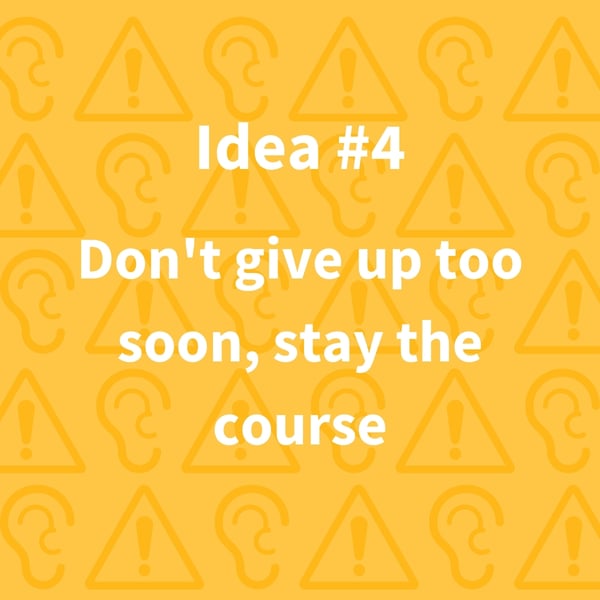This blog post is the fourth and final post in a series exploring the ideas I shared in a LinkedIn article titled "Beware of hearing what you want to hear". Though the original article was about my experiences at Veracity Solutions, I hope you'll be able to apply these ideas to your projects and relationships.
Four ideas that I've found to be important as we help clients execute on their digital transformation projects are:
- Clarify expectations, speak them back, rinse and repeat
- Define the roles that are needed to do the work, and then agree on who is doing them
- Have the hard conversations quickly and openly
- Don't give up too soon, stay the course
In the previous post, I explored idea #3: Have the hard conversations quickly and openly.
For this final post we’ll be talking about idea #4:
Don't give up too soon, stay the course

We've all probably heard that "patience is a virtue." Most people would agree with that. At the same time, we've all probably experienced moments when we are tired of waiting for something to happen. I've heard a proverb that goes something like this:
"Everything takes longer than it does."
.png?width=600&name=Beware%20of%20Hearing%20What%20You%20Want%20to%20Hear%20Ideas%20(3).png)
When it comes to finding success during a project, waiting can be frustrating. This is especially true if you've worked hard to keep the team on target:
Despite these efforts, things on the project aren't working very well. Progress is slow, or maybe things even seem to be getting worse.
So, what should you do?
Cancel the project?
Fire the team?
Abandon ship?
When our project is in a bad place it is tempting to lose patience and take extreme measures. But we need to react with both patience and prudence.
I propose that you should stay curious about the problems and investigate the situation deeper to identify root issues.
I find that root issues often fall into three buckets: Purpose, Process, and People. The three ideas that we’ve talked about in previous posts can be mapped to these three buckets:
- PURPOSE: Clarify expectations and align on a clear vision
- PROCESS: Define roles and align on them
- PEOPLE: Have the crucial conversations
Purpose-related Issues
Purpose-related issues can show up in symptoms like lack of passion, lack of unity, or disagreement on priorities. If you feel the root issues are Purpose related, then I recommend that you take time with the team to dig back into the expectations, vision, and goals of the project. Patience comes into play here because it seems like it often takes several alignment cycles before a team owns a vision. Sometimes it can seem like there is alignment, but as work begins it becomes clear that there are outliers who aren’t on the same page. Perhaps they just didn’t absorb the vision yet, or perhaps they disagree with the vision but haven’t voiced their concerns. Once again, review the Vision, Goals, and Plan with the team to try to get everyone aligned.
Process-related Issues
Process-related issues can show up in symptoms like duplication of effort, lack of accountability, or disagreement of who is doing what. If you feel the root issues are Process related, then it is good to review the process and roles once again with the team. As before, a visible RACI chart is usually helpful in this conversation. Patience is important here because human beings usually take some time to change their behavior. This is especially true if they have been doing things a certain way for a long time. Old habits can be hard to break. If a team is changing how they work together then you should expect the journey to take some time and have a few bumps along the way.
People-related Issues
People-related issues can show up in symptoms like infighting, fractured relationships, poor communication, and frustrated team members. If it seems like the root issues are People related, then this might require the most patience of the three areas. Good relationships take time to cultivate. Trust takes time to build. If trust has been broken, then it takes even more time to rebuild. In these situations, recommit yourself to being a courageous leader and having crucial conversations. Work to be a bridge-builder and peacemaker with your team. Hold people accountable. Hopefully, you can avoid difficult situations like removing team members, which should be a last resort.
How to Manage Project Issues
If you find yourself with a struggling project, then I can’t tell you how long you should wait before taking extreme measures. At a certain point, you might have to do something drastic like cancelling the project or disbanding the team, but in my experience, that doesn’t happen often. Before you completely change direction, I encourage you to try the above ideas to take small pivots while continuing to move forward towards the goal. I’ve found that in most cases things will begin to change for the better, but it does take some time. Once things begin to change for the better, that often creates positive momentum, and the rate of progress accelerates.
I agree that it seems like “everything takes longer than it does," but I encourage you to stay the course.
What was once a struggle might become a newfound success.


.png?width=600&name=Beware%20of%20Hearing%20What%20You%20Want%20to%20Hear%20Ideas%20(3).png)
